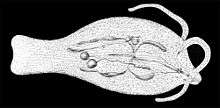Phylliroe
| Phylliroe | |
|---|---|
 | |
| A drawing of Phylliroe bucephalum | |
| Scientific classification | |
| Kingdom: | Animalia |
| Phylum: | Mollusca |
| Class: | Gastropoda |
| (unranked): | clade Heterobranchia clade Euthyneura clade Nudipleura clade Nudibranchia clade Dexiarchia clade Cladobranchia clade Dendronotida |
| Superfamily: | Tritonioidea |
| Family: | Phylliroidae |
| Genus: | Phylliroe Péron & Lesueur, 1810[1] |
| Species | |
| |
Phylliroe is a genus of average sized (up to 5.5 centimetres or 2.2 inches), highly transparent pelagic nudibranchs, marine gastropod molluscs in the order Opisthobranchia, that consists of two known species.[2]
Distribution
- P. atlantica occurs in the (sub) tropical waters of the Atlantic and Pacific oceans.
- P. bucephalum is known from the Mediterranean.[3]
Ecology
Juveniles of P. bucephalum are found exclusively feeding on the bell of the hydromedusa Zanclea costata (this junior synonym was given precedence over Mnestra parasites). At first the nudibranch is attached to the inside of the bell of the meduse with its very small foot. It sucks tissue from the ring, radial canals and manubrium of the meduse and grows from 1.6 mm to 11 mm in just ten days, while the meduse shrinks. When the slug is as big as the meduse, it starts to swim, eating the remaining parts, including the tentacles.[3]
In adulthood its diet is no longer restricted to Zanclea, although observations of feeding behaviour are sparse. Phylliroe has been seen approaching a swarm of the larvacean Oikopleura albicans from below, grabbing a specimen with its paired denticulate jaws and swallowing it in half a minute. Adults have also been observed to prey on the meduse Aequoria.[3]
Branches of the digestive tract may contain symbiontic zooxanthellae, but this relationship has not yet been studied. It is unclear if all specimens of P. bucephalum harbor these symbionts. It is possible they are obtained from their prey.[3]
P. bucephalum sometimes suffers from parasitic trematodes, both attached to its skin and inside its body.[3]
References
- ↑ Péron & Lesueur C. A. (1810). "Histoire de la famille des Mollusques Ptéropodes. Caractères des dix genres qui doivent la composer". Annales du Muséum National d'Histoire Naturelle 15: 57-69, page 65, plate 1, fig. 1-3.
- ↑ Helm, R.R. "Meet Phylliroe: the sea slug that looks and swims like a fish". Deep Sea News. Retrieved 22 November 2015.
- 1 2 3 4 5 Lalli, Carol M.; Gilmer, Ronald W. (1989). Pelagic Snails: The Biology of Holoplanktonic Gastropod Mollusks. Stanford University Press.
External links
Further reading
- "Phylliroe". Integrated Taxonomic Information System.
- Powell A. W. B., New Zealand Mollusca, William Collins Publishers Ltd, Auckland, New Zealand 1979 ISBN 0-00-216906-1